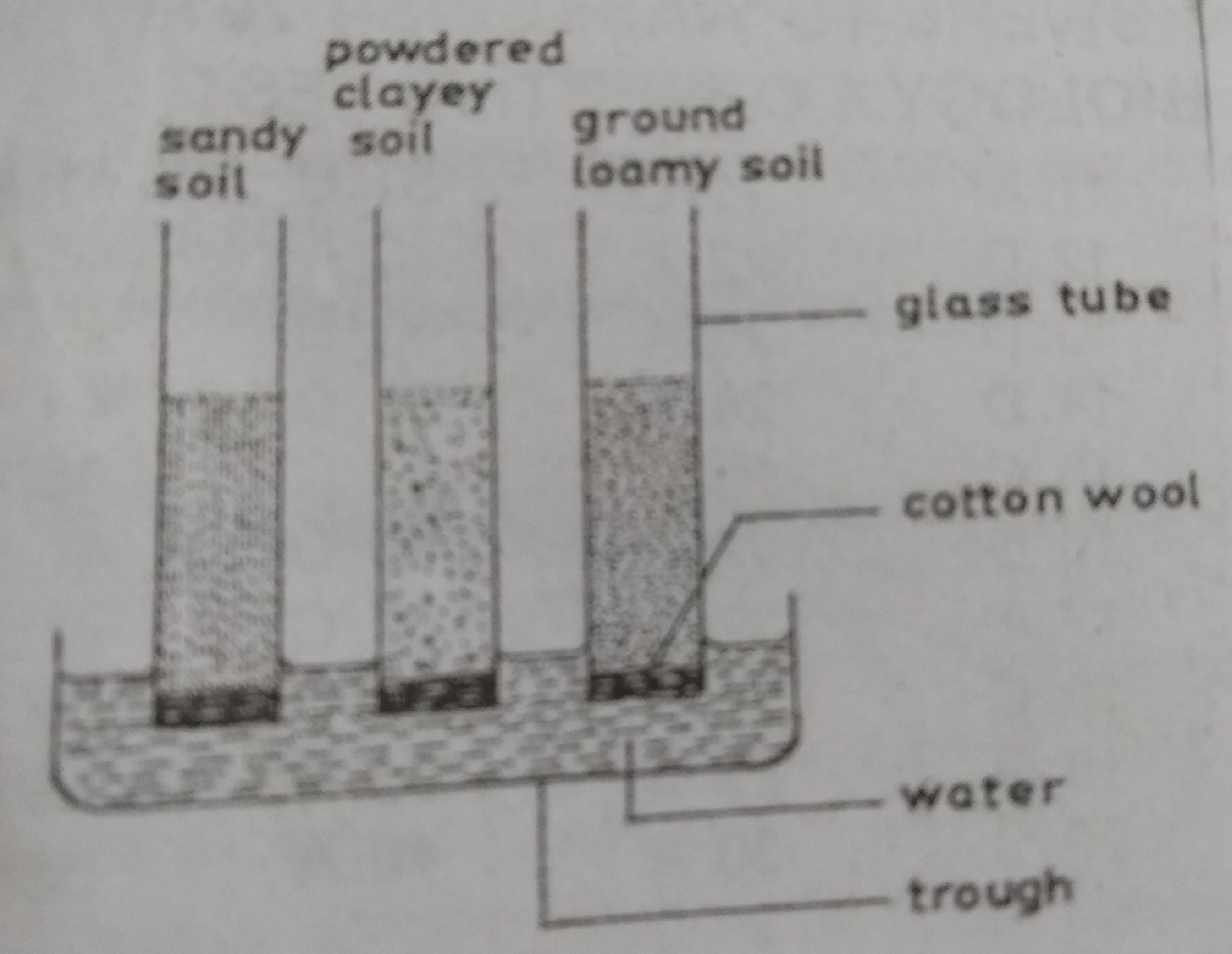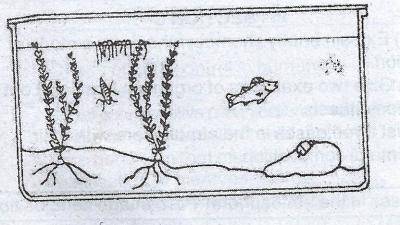Year :
2018
Title :
Biology
Exam :
WASSCE/WAEC MAY/JUNE
Paper 1 | Objectives
21 - 30 of 49 Questions
| # | Question | Ans |
|---|---|---|
| 21. |
The source of energy required by plants during food production is A. Photosynthesis B. Chlorophyll C. Sunlight D. Microorganisms Detailed SolutionThe food production process (photosynthesis) makes use of the energy of light for the process. |
|
| 22. |
One major difference between plant and animals nutrition is the ability of plants to synthesize A. Food for plants and animals B. Water for plants C. Water for animals D. Food for plants only Detailed SolutionThe food produced by plants serve as food both for the plants and animals (herbivores and in extension, all animals.) |
|
| 23. |
By what process is starch converted into maltose? A. Hydrolysis B. Condensation C. Translocation D. Photosynthesis Detailed SolutionCarbohydrates are broken down into their component sugars by hydrolysis. This type of hydrolysis is called Saccharification. |
|
| 24. |
The ascent of water in tall trees is mainly due to A. adhesive forces B. transpiration pull C. root pressure D. cohesive forces Detailed SolutionTranspiration pull or the suction force is the force which aids in drawing the water upward from roots to leaves which is used by the leaves for photosynthesis and excess is released through the stomata. |
|
| 25. |
The duodenum of a person was surgically removed. Which of the following substances would have their digestion affected? A. starch and protein only B. starch and lipids C. starch, peptones and maltose D. starch, protein and lipids Detailed SolutionThese three (starch, protein and lipids) have a process to undergo in the duodenum (the beginning of the small intestine), therefore, the surgery will affect them. |
|
| 26. |
Which of the following dental formulae represents the dentition in rabbits? A. \(I\frac{2}{1}\) \(C\frac{0}{0}\) \(P\frac{3}{2}\) \(M\frac{3}{3}\) B. \(I\frac{2}{2}\) \(C\frac{1}{1}\) \(P\frac{2}{2}\) \(M\frac{3}{3}\) C. \(I\frac{1}{2}\) \(C\frac{0}{0}\) \(P\frac{2}{3}\) \(M\frac{3}{3}\) D. \(I\frac{2}{1}\) \(C\frac{0}{1}\) \(P\frac{3}{2}\) \(M\frac{3}{3}\) Detailed SolutionThe normal dental formula of rabbits is I2/1 C0/0 P3/2 M3/3 for 28 teeth. |
|
| 27. |
 The diagram above is an illustration of an experimental set-up to demonstrate a property of soil. The property of soil demonstrated is A. particle size B. capillarity C. colour D. texture Detailed SolutionThe setup is to show the capillarity (water rise) of each of the soil types |
|
| 28. |
Which of the following statements would be a correct observation at the end of the experiment? Water moves A. highest in sandy soil B. lowest in loamy soil C. to the same level in all soil types D. highest in clayey soil Detailed SolutionCapillarity in soil refers to the ability of a soil to allow and retain water in it. Clayey soil has the highest tendency to hold water hence, the water would rise highest in it. |
|
| 29. |
The most important factor(s) that influence(s) the ecological niche of an organism is/ are the A. water, light and predator-prey relationship B. food and water availability C. physical environment D. competition for food and space Detailed SolutionThe competition in a territory is the factor that basically determines whether or not a specie will survive or not in that territory. Ecological niche is the total package of the habits of a specie. The competition for food and water is the most important influencer of the ecological niche. |
|
| 30. |
 The diagram above is an illustration of organisms in an air-tight aquarium.The most important factor needed by the organisms is A. light energy B. low humidity C. oxygen D. nitrate Detailed SolutionProper light in the aquarium serves as a form of energy for the photosynthetic plants and animals, hence is very important. |
| 21. |
The source of energy required by plants during food production is A. Photosynthesis B. Chlorophyll C. Sunlight D. Microorganisms Detailed SolutionThe food production process (photosynthesis) makes use of the energy of light for the process. |
|
| 22. |
One major difference between plant and animals nutrition is the ability of plants to synthesize A. Food for plants and animals B. Water for plants C. Water for animals D. Food for plants only Detailed SolutionThe food produced by plants serve as food both for the plants and animals (herbivores and in extension, all animals.) |
|
| 23. |
By what process is starch converted into maltose? A. Hydrolysis B. Condensation C. Translocation D. Photosynthesis Detailed SolutionCarbohydrates are broken down into their component sugars by hydrolysis. This type of hydrolysis is called Saccharification. |
|
| 24. |
The ascent of water in tall trees is mainly due to A. adhesive forces B. transpiration pull C. root pressure D. cohesive forces Detailed SolutionTranspiration pull or the suction force is the force which aids in drawing the water upward from roots to leaves which is used by the leaves for photosynthesis and excess is released through the stomata. |
|
| 25. |
The duodenum of a person was surgically removed. Which of the following substances would have their digestion affected? A. starch and protein only B. starch and lipids C. starch, peptones and maltose D. starch, protein and lipids Detailed SolutionThese three (starch, protein and lipids) have a process to undergo in the duodenum (the beginning of the small intestine), therefore, the surgery will affect them. |
| 26. |
Which of the following dental formulae represents the dentition in rabbits? A. \(I\frac{2}{1}\) \(C\frac{0}{0}\) \(P\frac{3}{2}\) \(M\frac{3}{3}\) B. \(I\frac{2}{2}\) \(C\frac{1}{1}\) \(P\frac{2}{2}\) \(M\frac{3}{3}\) C. \(I\frac{1}{2}\) \(C\frac{0}{0}\) \(P\frac{2}{3}\) \(M\frac{3}{3}\) D. \(I\frac{2}{1}\) \(C\frac{0}{1}\) \(P\frac{3}{2}\) \(M\frac{3}{3}\) Detailed SolutionThe normal dental formula of rabbits is I2/1 C0/0 P3/2 M3/3 for 28 teeth. |
|
| 27. |
 The diagram above is an illustration of an experimental set-up to demonstrate a property of soil. The property of soil demonstrated is A. particle size B. capillarity C. colour D. texture Detailed SolutionThe setup is to show the capillarity (water rise) of each of the soil types |
|
| 28. |
Which of the following statements would be a correct observation at the end of the experiment? Water moves A. highest in sandy soil B. lowest in loamy soil C. to the same level in all soil types D. highest in clayey soil Detailed SolutionCapillarity in soil refers to the ability of a soil to allow and retain water in it. Clayey soil has the highest tendency to hold water hence, the water would rise highest in it. |
|
| 29. |
The most important factor(s) that influence(s) the ecological niche of an organism is/ are the A. water, light and predator-prey relationship B. food and water availability C. physical environment D. competition for food and space Detailed SolutionThe competition in a territory is the factor that basically determines whether or not a specie will survive or not in that territory. Ecological niche is the total package of the habits of a specie. The competition for food and water is the most important influencer of the ecological niche. |
|
| 30. |
 The diagram above is an illustration of organisms in an air-tight aquarium.The most important factor needed by the organisms is A. light energy B. low humidity C. oxygen D. nitrate Detailed SolutionProper light in the aquarium serves as a form of energy for the photosynthetic plants and animals, hence is very important. |